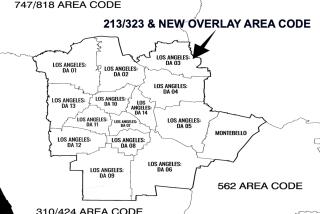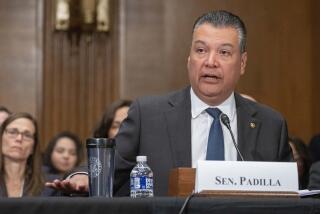Busy Signal
- Share via
To split or to overlay, that is the question.
With the 213 area code fast running out of numbers, phone customer Tom Bratter--a virtual encyclopedia of telephonic facts--believes anyone with a 213 number should keep it, and all new lines should get a new three-digit code: the “overlay” method.
Helen M. Mickiewicz of the state Public Utilities Commission says consumers will benefit from increased competition among phone companies if Downtown gets to keep 213 and a doughnut-shaped swath around that core moves to a new area code: the “split” method.
Pacific Bell says overlay. AT&T; says split.
In a city that might shut down like a pager with a dead battery if not for its cellular phones, fax machines and, well, fully powered pagers, all sides can agree on two things: a new area code is coming in 1998, and hardly anybody is going to be happy.
“It used to happen to you once every 15 years. Maybe,” Pacific Bell spokeswoman Linda Bonniksen said of the new area code coming to town. “Now it’s happening every few years.”
Our phone number is only a number, yes. Any other would work just as well. But it is a number that has come to identify and define us perhaps more than any other.
And at a series of hearings held Monday and Tuesday in communities that will be affected when a new area code comes to town, customers told representatives from telephone companies and state regulatory agencies just what a technical, financial and emotional headache this is going to be.
Hollywood Hills resident Andrew Susser, 51, said all he wants is to keep his number.
“I’ve lived in that area for over 40 years,” he said. “My family has had the same number that whole time.”
Even more than the potential loss of a good numerical friend, however, proponents of the overlay method were concerned about cost. If they get to keep their old numbers, they don’t have to pay for stationery and related expenses.
“I really don’t care if my area code changes as long as someone pays for my business cards,” said 31-year-old photographer Patricia Andre.
She figures it would cost her about $5,000 to retool her four-color embossed business cards and stationery. And that’s just the beginning. She and her husband, a printer, both run businesses out of their home in Hollywood, which has six phone lines. The couple also have two cellular phones and two pager numbers.
Dennis Shelley of the County of Los Angeles said his agency may be the single largest customer facing this change, paying the bill on 45,000 phone numbers in the 213 area code alone.
“These [proposed] changes cost thousands of dollars and create confusion to the citizens of the county,” he said. “Stationery, directories, and forms . . . will need to be reprinted.”
Shelley suggested that the phone companies foot the bill for such costs.
While the majority of speakers touted the overlay plan as the least inconvenient, others disagreed.
The City of Hawthorne, population 71,000, already has two area codes. That’s one more than it had just four years ago.
With the overlay, “We’d get a third area code,” said city spokesman Mark Hardison.
Another problem, split proponents say, is that the overlay would mean that the person in the next cubicle at work could have a different area code. In fact, mom and dad’s phone could be in one code and their teenager’s in another.
And with an overlay, everyone now in the 213 area code might have to dial 1 plus 10 digits on all calls.
When the same debate over split versus overlay erupted in the 310 zone, the PUC decided that if the overlay method were chosen, everyone in the area would have to dial 1 plus 10 digits on all calls, even ones within their own area code. The PUC’s reason was that since for some time the vast majority of numbers would be ones with the original area code, it would be unfair if those customers could dial most neighbors by hitting just seven digits while the newcomers had to dial 10 for nearly everyone.
In the end, the PUC decided to go with a split on 310; next year, the Long Beach and Southeast areas will switch to area code 562. It will be their third area code in seven years. In 1998, most of the San Gabriel Valley will split from the 818 area code and answer to 626.
As the demand for phone lines continues to grow--as it will, and rapidly, experts say--10-digit dialing will be on the horizon for almost everyone.
California, which began with just three in 1947, now has 13. That number is expected to leap to 22 around the turn of the century.
(BEGIN TEXT OF INFOBOX / INFOGRAPHIC)
Today: 6 Area Codes
All of Los Angeles County once was in the 213 area codes, until the creation of the 818 area in 1984 began the process of splitting up the county.
1998: 9 Area Codes
By the end of 1998, area code 562 will be operating in the Long Beach and Southeast areas; most of the San Gabriel Valley should answer to 626, and the central core of Los Angeles might be the only remnant of the original 213, possibly surrounded by a doughnut of yet another area code.






